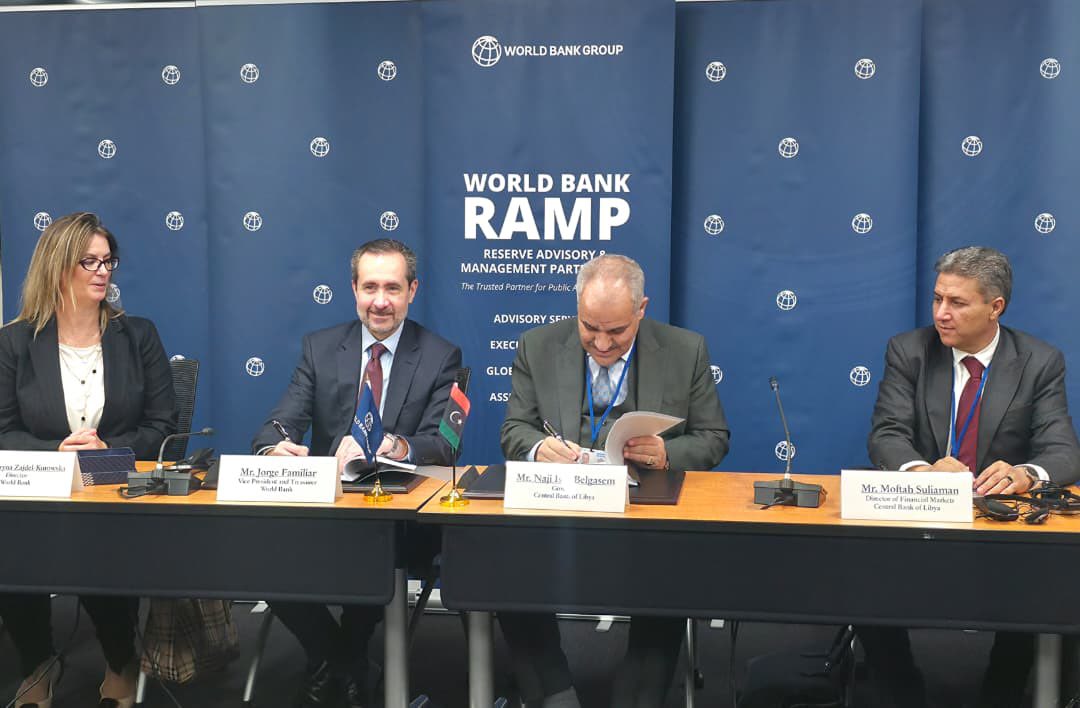RAMP Integration Marks Libya’s Institutional Maturity Phase
Libya’s RAMP integration strengthens reserve management and FX governance. With Brent (BZ=F) steady near $85 and EMB spreads tightening, investors see credible reform that could anchor inflation near 2–3% and reinforce Libya’s external balance through 2026.

The Central Bank of Libya’s entry into the World Bank’s Reserve Advisory and Management Partnership marks a calculated effort to institutionalize reserve management and rebuild credibility after years of monetary fragmentation. With foreign assets close to USD 98 billion by September 2025, a nominal GDP near USD 48 billion, and crude output averaging 1.25 million barrels per day, Libya’s macro buffers remain sizable but underleveraged.
The April 2025 13 percent devaluation aligned the official rate to roughly 5.43 LYD/USD, establishing a managed band that has since stabilized liquidity and narrowed parallel-market premia. Headline inflation, averaging 2.6 percent year-to-date versus 10 percent in 2021, reflects restored monetary coherence. The signal is strategic: Libya aims to shift from reserve accumulation by default to active balance-sheet governance anchored in transparency, diversification, and yield discipline.
RAMP participation enforces quantitative risk governance through benchmarking, duration management, and counterparty diversification—areas where the Central Bank of Libya historically lacked structure. The framework separates policy liquidity from fiscal cash management, constraining off-budget drawdowns that previously blurred accountability.
With major-currency policy rates plateauing and G7 bond yields normalizing near 3.5 percent, reallocating a modest share of Libya’s reserves from overnight placements to short-dated sovereign paper could lift portfolio returns by roughly USD 2 billion annually without impairing liquidity. The technical upgrade matters for a nation whose external assets exceed twice its public debt but have yielded below-market returns due to concentration in low-yield deposits.
The fiscal-monetary transmission is now cleaner. Hydrocarbon receipts of roughly USD 14.6 billion in the first nine months of 2025 provide the core hard-currency inflow. Stronger reserve governance tightens FX-auction discipline, compressing import premia and dampening consumer-price volatility. Lower input costs pass through to the CPI with a two-quarter lag, reinforcing real-income stability.
On the sovereign balance sheet, improved reserve income cushions cyclical shortfalls without reverting to monetary financing, reducing tail risks to dinar stability. The fiscal deficit, estimated near 6 percent of GDP in 2025, becomes more manageable when reserve-derived income offsets 0.5–0.8 percent of GDP in lost oil revenue during soft-price phases.
Markets interpret the move as a durable normalization path rather than a symbolic gesture. A rules-based reserve regime typically compresses sovereign risk premia across emerging-market peers lacking active Eurobond curves by improving perceived investability. For investors tracking the J.P. Morgan Emerging Market Bond Index (EMB) or regional spreads, the correlation is clear: credible reserve management narrows five-year implied CDS by 50–100 basis points once transparency thresholds are met.
If Brent crude (BZ=F) sustains an USD 80–90 range and reserve-portfolio disclosures remain quarterly, Libya’s external balance could stabilize near a 9-month import-cover norm, aligning with Egypt and Morocco averages. Lower FX volatility will also reduce domestic bank settlement risk and shorten payment tenors, improving private-sector liquidity velocity.
Forward risk lies in governance continuity. Any relapse into dual institutional control or opaque fiscal withdrawals would erode credibility and widen FX spreads. A sustained USD 10/barrel decline in Brent would cut export receipts by roughly USD 3.5 billion annually, tightening reserve coverage unless offset by portfolio income. Renewed volatility in core sovereign yields could also trim mark-to-market gains, limiting duration extension.
These risks are measurable: interbank FX spreads against the official rate, quarterly reserve composition reports, realized portfolio income versus budget, and CPI stabilization within the 2–3 percent corridor through 2026.
If the central bank sustains RAMP-aligned governance, transparent reporting, and positive reserve carry through end-2026, Libya will have shifted from discretionary liquidity defense to structured asset stewardship—an institutional transformation that investors will price into future sovereign placements, bank lines, and trade-credit costs.





